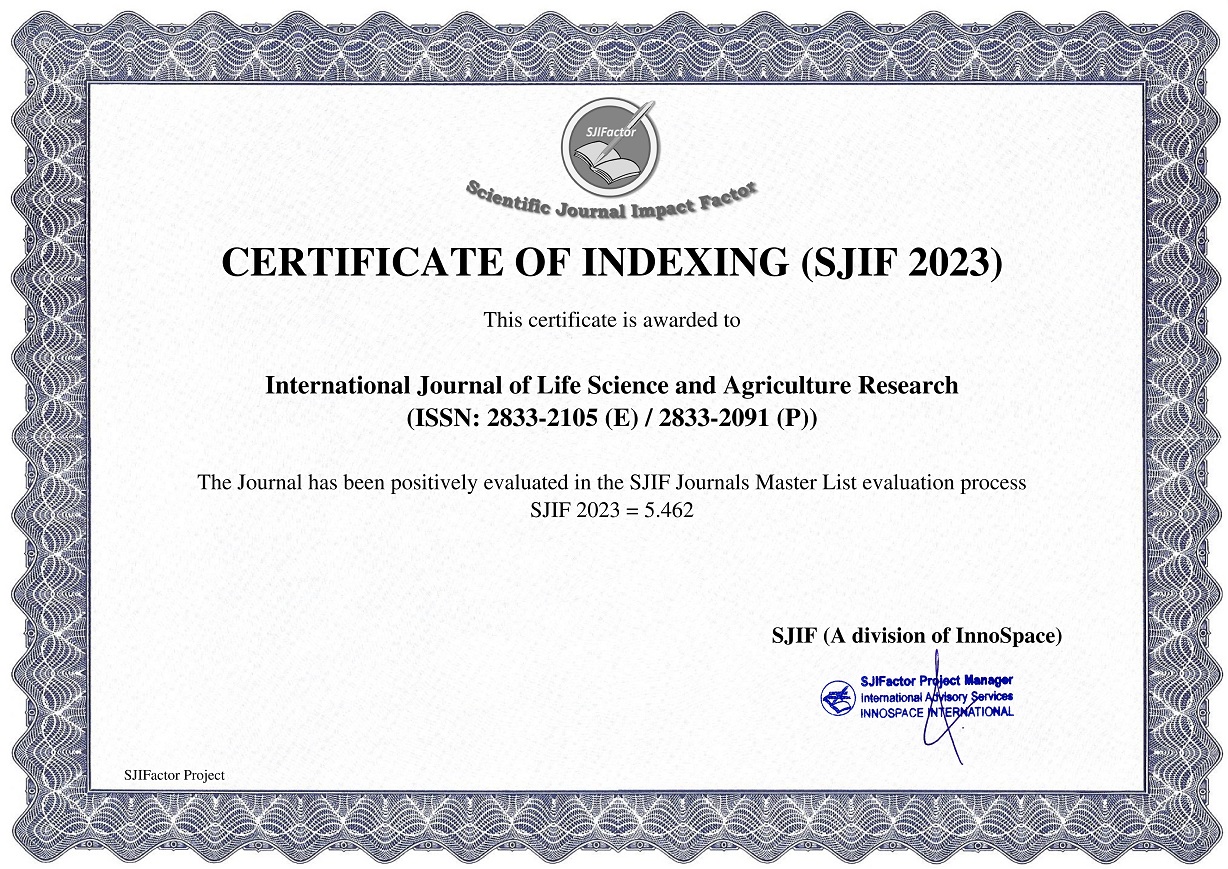Dietary Tryptophan Supplementation Made No Difference on the Cannibalism, Survival and Growth of Heterobranchus longifilis fingerlings
DOI:
https://doi.org/10.55677/ijlsar/V03I1Y2024-02Keywords:
Heterobrancus longifilis, Typtophan, Growth, Cannibalism, Mortalities, SurvivalAbstract
Heterobranchus longifilis is a popular cultured and food fish but its cannibalism greatly reduces harvest thus necessitating proactive control measures. Tryptophan is believed to raise the serotogenic activity in the brain at certain levels leading to reduced aggression and cannibalism in certain species of fish which possibilities this research tried to explore in Heterobranchus longifilis. Fingerlings (0.58 ± 0.123g mean weight and 3. 8 ± 0.52cm mean length) were stocked in 18 round plastic tanks, each 45 litres containing 40 litres of water, at 45 fish per tank. Tryptophan was incorporated at 0.0, 0.5, 1.0, 1.5, 2.0 and 2.5 % in commercial Catfish feed by spraying each tryptophan - 70% alcohol solution to separate feed samples to form six different experimental feeds. The dried feeds were fed to the fish daily at 4 % body weight for 8 weeks. The experiment used a complete randomized design with 6 feed treatments and 3 replications. Water quality, growth, mortality and feed utilization data noted and at the end, their associated indices were determined and subjected to the analysis of variance for significant differences (P= 0.05). The results revealed that tryptophan supplementation at the levels used in the diets of Heterobranchus longifilis did not have any significant effects on all the parameters examined excepting mean weight gain. This was discussed in the context of growth and cannibalism.
References
Anselme,P., P. Bernaerts and P.Poncin. 2008. Daily activity rhythms of thenAfrican catfish Heterobranchus longifilis (Claridae) in an experimental enclosure. Aquatic living resources, Vol21, Issue 4, 419 – 422. DOI : https://doi.org.10.1051/alr:2008055
Baras E, Jobling M. 2002. Dynamics of intracohort cannibalism in cultured fish. Aquac Res 33:461–479. doi:10.1046/j. 1365-2109.2002.00732.x
Baras, E., F. Tissier, L.Westerloppe, C. Meelard, J-C. Philippart. 1998. Feeding in darkness alleviates density - dependent growth of juvenile vundu catfish, Heterobranchus longifilis (Clarridae). Aquat. Living Resour Vol. 11, Issue 5, 335 - 340. DOI: https//doi.10.1016/S0990-7440(98)80004-1
Baras, E., R.Dugue and M. Legendre. 2014.Do cannibalistic fish forage optimally? An experimental study of prey size preference, bioenergetics of cannibalism and their ontogenetic variations in the African catfish Heterobranchus longifilis. Aquat. Living Resour. 27, 51–62 DOI: 10.1051/alr/2014006
Basic, D., Å. Krogdahl, J. Schjolden, S. Winberg, M.A.Vindas, M. Hillestad, I. Mayer, E. Skjerve, E. Höglund, . 2013. Short-and long-term effects of dietary l-tryptophan supplementation on the neuroendocrine stress response in seawater-reared Atlantic salmon (Salmo salar). Aquaculture, 388, 8-13.
Biswas, P., Rawat, P., Patel, A.B. and Jena, A.K. 2018. Dietary supplementation of L-tryptophan: Effect on growth and survival of Pabda, Ompok bimaculatus (Bloch) fry. J. Appl. Aquaculture, 1-15.
Cubitt, K. F., S. Winberg, et al. 2008. "Social hierarchies, growth and brain serotonin metabolism in Atlantic salmon (Salmo salar) kept under commercial rearing conditions." Physiology
de Pedro N., Pinillos M.L., Valenciano A.I., Alonso-Bedate M., Delgardo M.J. 1998. Inhibitory effect of serotonin on feeding behavior in goldfish: Involvement of CRF. Peptides 19 (3):505–511. DOI: 10.1016/S0196-9781(97)00469-5
Höglund E, Bakke M. J, Øverli Ø, Winberg S, Nilsson G. E. 2005. Suppression of aggressive behaviour in juvenile Atlantic cod (Gadus morhua) by L-tryptophan supplementation. Aquaculture.; 249(1-4):525-531.
Hoseini, S. M., Pérez-Jiménez, A., Costas, B., Azeredo, R., & Gesto, M. 2019. Physiological roles of tryptophan in teleosts: current knowledge and perspectives for future studies. Reviews in Aquaculture (Print), 11(1), 3-24. https://doi.org/10.1111/raq.12223
Hseu J.R., F.I. Lu., H.M. Su, L.S.Wang, C.L. Tsai., P.P. Hwang. 2003. Effect of exogenous tryptophan on cannibalism, survival and growth in juvenile grouper, Epinephelus coioides. Aquaculture 218 (1–4): 251–263.
DOI: 10.1016/S00448486(02)00503-3
Kamaruddin, Usman, Rachmansyah (2006) Effect of tryptophan added than cannibalism level. Survival rate and growth juvenile of grouper, Epinephelus fuscoguttatus. Makalah disampaikan dalam seminar nasional dan temu bisnis ikan kerapu di Den Pasar Bali Tanggal, Indonesia.
Król J., Flisiak W., Urbanowicz P., Ulikowski D. 2014. Growth, cannibalism, and survival relations in larvae of European catfish, Silurus glanis (Actinopterygii: Siluriformes: Siluridae)—attempts to mitigate sibling cannibalism. Acta Ichthyol. Piscat. 44 (3): 191–199. DOI: 10.3750/AIP2014.44.3.03
Król, J. and Z. Zake. 2016. Effect of dietary L-tryptophan on cannibalism, survival and growth in pikeperch Sander lucioperca (L.) post-fry. Aquac. Int. 24, 441-451. DOI 10.1007/s10499-015-9936-1
Kumar, P., M. Kailasam, S. N. Sethi, K. Sukumaran, G. Biswas, R. Subburaj, G. Thiagarajan, T. 2017. Effect of dietary L-tryptophan on cannibalism, growth and survival of Asian seabass, Lates calcarifer (Bloch, 1790) fry Indian J. Fish., 64(2): 28-32. DOI: 10.21077/ijf.2017.64.2.61333-05
McDonald, J. H. 2014. Test for one measurement variable: Data transformation. In: Hand book of Biological Statistics. 3rd Edition. Soarky House Publishins, Baltimore, USA. Pp 140 - 145.
Naumowicz Karolina; Joanna Pajdak; Elzbieta Terech Majewska; Jo´zef Szarek. 2017. Intracohort cannibalism and methods for its mitigation in cultured freshwater fish. Rev Fish
Rawat, P., Biswas, P., Patel, A.B. and Saha, H. 2018. Effect of Dietary Incorporation of Chemo-Attractants on Growth and Survival during Seed Rearing of Ompok bimaculatus (Bloch). Turkish J. Fish. Aquat. Sci. 18, 491499.
Sangavi, S., A.K. Jena, S. S. Pattanaik and J.C. Betsy. 2019. Effect of dietary l-tryptophan supplementation on growth and survival of striped murrel, Channa striatus (BLOCH, 1793) FRY. Global Journal of Bioscience and Biotechnology, Vol.8 (3) 2019: 307-311
Schjolden, J., K. G. T. Pulman, et al. 2006. "Serotonergic characteristics of rainbow trout divergent in stress." Physiology & Behaviour 87: 938-947.
Suharyanto Y, Y. Himawan 2015. Applications Tryptophan and Glycine in Feed and Its Effect on the Level of Post Larva Cannibalism and Survival Rate of Giant Prawn (Macrobrachium rosenbergii, de Mann). J Aquac Mar Biol 3(2): 00060. DOI: 10.15406/jamb.2015.03.0006
Umanah, S.I and A. A. Nlewadim. 2019. Implications of Size Heterogeneity and Food Availability on the Survival of Heterobranchus Longifilis Fingerlings. Journal of Aquatic Science and Marine Biology, Volume 2, Issue 2, PP 17-23.
Winberg S, Øveril Ø, Lepage O. 2001. Suppression of aggression in rainbow trout (Oncorhynchus mykiss) by dietary L-tryptophan. J Exp Biol 204:3867–3876





